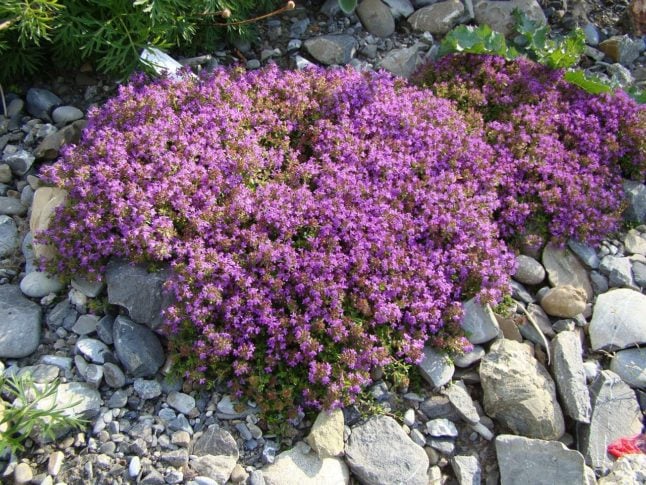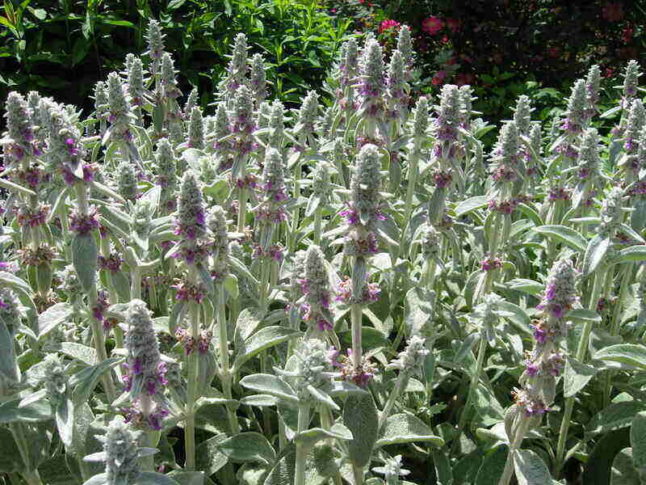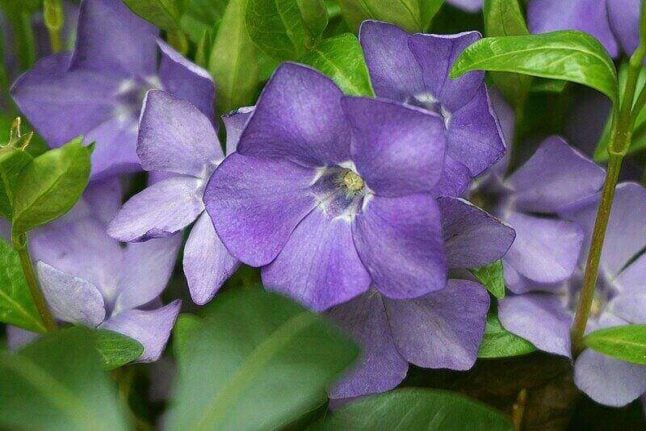
Flowering ground covers are the most useful tools in landscape design. They’re low-maintenance, drought-tolerant, and multi-functional, and they bring eye-popping curb appeal when in bloom.
Do you have a hilly area in your yard that’s difficult to mow? Unsightly roots that you’d like to cover? A driveway in need of an attractive border? Flowering ground covers can solve all these problems and look beautiful while doing it. Here are 10 of the best flowering ground cover plants for your garden or landscape.
1. Ice Plant (Delosperma)

Delosperma refers to a genus of more than 100 different species of succulent plants. Delosperma cooperi, also known as Cooper’s ice plant, is a mat-forming evergreen with big purple flowers that bloom from early summer to fall. The vibrant color and long blooming season of the ice plant makes it a top choice for bold garden color.
USDA Hardiness Zones: 6 to 10
Examples of Delosperma varieties: Fire spinner, jewel of the desert, kelaidis, wheels of wonder
Care: Easy to grow. Thrives in full sun but requires dry, well-draining soil to flourish.
Flowering: Ice plants produce large, deep purple, daisy-like flowers from early summer to fall.
Spread: Via seed
Cost: Seeds cost about $5 for 500. You’ll pay up to $10 for a plant tray, and about $125 for 25 container plants.
2. Lilyturf (Liriope)

Sometimes referred to as monkey grass, this flowering perennial is ultra-tough. The plant itself is tall and grass-like so it works well as an edging plant or to prevent erosion. Liriope flowers in the late summer and will produce tall shoots with lavender flower spikes.
USDA Hardiness Zones: 4 to 10
Examples of Liriope varieties: Liriope spicata and liriope muscari
Care: Low-maintenance and highly drought-tolerant. Handles both full sun and partial shade. Requires medium to well-draining soil
Flowering: Tall flowers of vibrant lavender to white bloom late summer to early fall
Spread: Spreads vigorously via creeping rhizomes and can be considered invasive in certain regions
Cost: Ranges from about $7 for five seeds to almost $120 for a 54-count tray.
3. Canada Anemone (Anemone canadensis)

Canada anemone is a hardy, low-growing ground cover plant that produces showy white flowers from April through June. Also known as meadow anemone or roundleaf thimbleweed, this perennial wildflower looks great, can handle some foot traffic, and grows easily.
Note: This plant is aggressive, so it should quickly become a beautiful green mat with spectacular white blooms.
USDA Hardiness Zones: 3 to 8
Care: Canada anemone can handle both full sun and partial shade. Prefers medium to medium wet soil conditions but may need pruning because of its aggressive nature.
Flowering: Each tall stalk produces one bright white flower with five petals and a yellow center. Flowers April through June.
Spread: Spreads vigorously via rhizomes. Can reseed itself under the right conditions
Cost: Seeds cost $3 for a packet of 200, 3-inch pots run $4 to $7 each.
4. Creeping Thyme (Thymus serpyllum)

“Creeping thyme” is the common name for a group of several perennial ground cover plants of the thymus genus. These low-growers thrive in full sun and are an attractive choice for sunny gardens thanks to their low, vine-like growth habit and beautiful flowers. While these varieties aren’t as tasty as the thyme in your spice rack, they are pleasantly aromatic.
USDA Hardiness Zones: 4 to 9 (depending on variety)
Examples of ground cover thyme plants: English thyme, caraway thyme, wooly thyme
Care: These low-maintenance plants need full sun and well-draining soil
Flowering: Creeping thyme produces large blooms of purple, pink, or white flowers from late spring to mid-summer
Spread: All thyme plants spread by above-ground stems, but varieties will range from slow to moderate to fast spreaders
Cost: A pack of 5,000 seeds costs about $5 online, container plants run about $40
5. Creeping Phlox (Phlox subulata)

Creeping phlox is a sun-loving and drought-resistant ground cover plant that generates a carpet of color in the spring. It works well as ground cover throughout most of the year, but its abundant springtime blooms are the star of the creeping phlox show.
USDA Hardiness Zones: 3 to 10
Examples of creeping phlox varieties: scarlet flame, candy stripe, emerald blue, phlox volcano
Care: Low-maintenance, but requires rich and well-drained soil. You’ll want to trim plants back in the winter
Flowering: Dense, springtime blooms of purple, red, white, blue, rose, lavender, or pink flowers
Spread: Moderate spread of up to 2 feet, by way of stolons
Cost: From $4 (seed packet) to $10 (trays) to $14 (potted)
6. Bugleweed (Ajuga reptans)

Bugleweed is a quick-spreader that works well covering areas where grass struggles. It’s versatile and can handle most conditions, thriving in everything from full sun to full shade and heavy foot traffic. It also doesn’t hurt that it brings added curb appeal with its attractive blue flower spikes that bloom from May through June.
USDA Hardiness Zones: 3 to 10
Examples of bugleweed varieties: black scallop, burgundy glow, pink beauty, catlin’s giant
Care: These are low-maintenance in large areas but will require some diligence to control in smaller areas. Runners should be pruned twice a year and as needed when escaping their desired planting area
Flowering: Violet, purple, or blue flower spikes in the mid to late spring
Spread: Spreads aggressively via runners, making it best used to fill large areas
Cost: Seeds range based on quantity from $4 to $400. A tray of these fast-spreading plants costs about $12
7. Spotted Deadnettle (Lamium maculatum)

Easy to grow and tolerant of most soil conditions, spotted deadnettles are great perennial ground covers for shaded areas. These low-growing plants are resilient and can even be evergreen in warmer climates. Their green leaves are typically variegated and attractive on their own, but their abundant flowers are a beautiful addition in the late spring to early summer. Deadnettles are aggressive spreaders that can become invasive if not controlled.
USDA Hardiness Zones: 3 to 8
Examples of deadnettle varieties: Anne greenway, purple dragon, shell pink, beacon silver, orchid frost
Care: Drought-tolerant, grows best in shade, should be cut back after flowering to encourage fresh foliage growth. Dislikes high heat and humidity
Flowering: Pink, purple, and white flowers (depending on cultivar) from May to June
Spread: Spreads aggressively. Can be considered invasive in some areas.
Cost: Ranges in price from $6 to almost $20
8. Lamb’s Ear (Stachys byzantina)

Lamb’s ear is a sun-loving ground cover plant known for its velvety look and feel of its namesake foliage. Lamb’s ear is a vigorous perennial that spreads quickly and develops a low mat of leaves. As an added bonus, lamb’s ear produces spikes of purplish flowers up to 18 inches tall in the summer.
USDA Hardiness Zones: 4 to 7
Examples of lamb’s ear cultivars: big ears, silver carpet, Helen von stein, cotton boll
Care: Low-maintenance. Water only when soil is dry and trim back in the spring.
Flowering: Tall, light-purple flower spikes bloom in the summer
Spread: Spread aggressively through creeping stems and self-seeding. Deadheading can reduce spread by self-seeding
Cost: About $5 for a 1-quart pot, or a pack of 40 seeds for less than $10
9. Periwinkle (Vinca minor)

This tough, low-maintenance ground cover plant is an evergreen perennial that can handle full shade and partial sun. Also known as vinca minor, its vines keep it low to the ground. Both the broadleaf foliage and abundant flowers of the periwinkle make it an attractive choice for steep hillsides that are difficult to maintain. It also works well in areas where grass won’t grow.
USDA Hardiness Zones: 4 to 8
Examples of periwinkle varieties: alba, flore pleno, sterling silver, bowles variety
Care: Requires minimal care, though they may require some trimming to avoid invasive spread. Can be susceptible to disease in wet, humid climates
Flowering: Blue, lavender, white, or purple flower show in May, June, and sometimes the fall
Spread: Aggressively via above-ground runners. Can be invasive if left unchecked.
Cost: A tray of periwinkle typically costs about $15.
10. Sweet woodruff (Galium odoratum)

Sweet woodruff, named after the sweet smell of its deep green foliage, is an excellent ground cover plant for shady gardens. This mat-forming creeper prefers moist soil, but can tolerate drought and will even thrive in dry shade. It’s an extremely low-maintenance perennial that only requires care when you want to limit its growth.
USDA Hardiness Zones: 4 to 8
Care: Very low-maintenance. Thrives in most conditions. Runners may need occasional trimming to limit growth
Flowering: Blooms with white, star-shaped flowers in April and May
Spread: Spreads quickly by runners.
Cost: Get 200 seeds for $7 or a large, potted plant for under $20.
FAQs About Flowering Ground Cover Plants
Many varieties of ground covers, including many of those listed above, are notoriously fast-growers. Some can be invasive and are only recommended if you don’t mind them taking over the area where you plant them. Spotted deadnettle, lamb’s ear, periwinkle, and sweet woodruff are some of the fastest-growing varieties.
Most ground covers help prevent weeds because of the way they spread out and fill up spaces. Dragon’s blood sedum is one of the best because of its hardiness and tolerance to poor soil conditions.
Lavender has a pleasant smell and attractive bloom, and even though it’s a perennial, it is a high-maintenance ground cover. It does well in hot, dry areas but is slower to grow and spread than other ground cover plants.
When to Call a Landscaping Professional
Most flowering ground cover plants spread quickly and are easy to care for. A DIY addition of colorful ground covers to your rock garden or beneath a tree is an easy feat for even the non-gardener.
But what if you need to cover a large area, while preventing uncontrolled spread, in a fickle soil? If things get a bit complex, or you simply want the expert eye of a landscape designer, contact a local landscaping pro near you.
Main Photo Credit: Pxhere